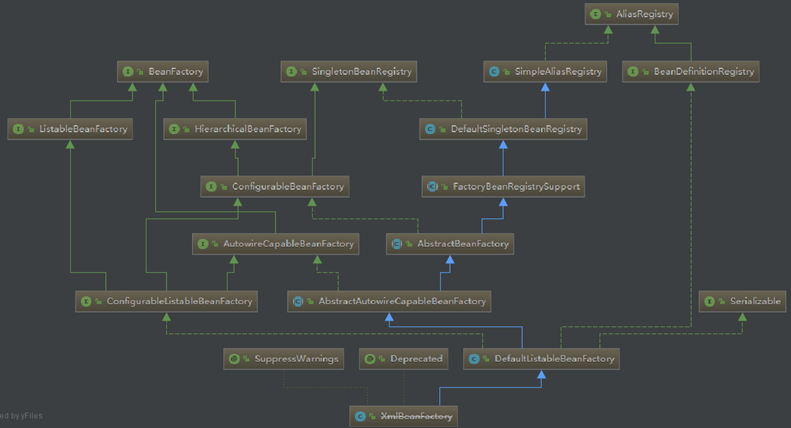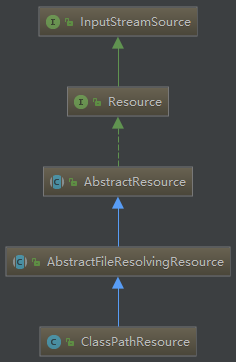жӮЁеҘҪпјҢзҷ»еҪ•еҗҺжүҚиғҪдёӢи®ўеҚ•е“ҰпјҒ
жӮЁеҘҪпјҢзҷ»еҪ•еҗҺжүҚиғҪдёӢи®ўеҚ•е“ҰпјҒ
жң¬зҜҮеҶ…е®№д»Ӣз»ҚдәҶвҖңSpringе®һзҺ°иҜ»еҸ–й…ҚзҪ®ж–Ү件зҡ„ж–№жі•вҖқзҡ„жңүе…ізҹҘиҜҶпјҢеңЁе®һйҷ…жЎҲдҫӢзҡ„ж“ҚдҪңиҝҮзЁӢдёӯпјҢдёҚе°‘дәәйғҪдјҡйҒҮеҲ°иҝҷж ·зҡ„еӣ°еўғпјҢжҺҘдёӢжқҘе°ұи®©е°Ҹзј–еёҰйўҶеӨ§е®¶еӯҰд№ дёҖдёӢеҰӮдҪ•еӨ„зҗҶиҝҷдәӣжғ…еҶөеҗ§пјҒеёҢжңӣеӨ§е®¶д»”з»Ҷйҳ…иҜ»пјҢиғҪеӨҹеӯҰжңүжүҖжҲҗпјҒ

BeanFactory bf = new XmlBeanFactory(new ClassPathResource("beanFactory.xml"));
public class XmlBeanFactory extends DefaultListableBeanFactory {
//ж ёеҝғд»Јз Ғ,XmlBeanFactoryдёӯдҪҝз”ЁдәҶиҮӘе®ҡд№үзҡ„XmlBeanDefinitionReaderиҜ»еҸ–XMLж–Ү件
XmlBeanDefinitionReader reader = new XmlBeanDefinitionReader(this);
public XmlBeanFactory(Resource resource, BeanFactory parentBeanFactory){
//иҜ»еҸ–XMLй…ҚзҪ®ж–Ү件зҡ„ж ёеҝғд»Јз Ғ
this.reader.loadBeanDefinitions(resource);
}
}еҠ иҪҪиө„жәҗж–Ү件еҸҜд»ҘдҪҝз”ЁSpringжҸҗдҫӣзҡ„зұ»пјҢеҰӮ
Resource resource = new ClassPathResource("beanFactory.xml");
//getInputStreamжҳҜеңЁInputStreamResourceдёӯе®ҡд№үзҡ„е”ҜдёҖж–№жі•,е®ғд№ҹжҳҜSpringеҜ№иө„жәҗе°ҒиЈ…зҡ„жңҖдёҠеұӮжҺҘеҸЈ
InputStream inputStream = resource.getInputStream();
public interface InputStreamSource {
InputStream getInputStream() throws IOException;
}
public interface Resource extends InputStreamSource {
boolean exists();
boolean isReadable();
boolean isOpen();
URL getURL() throws IOException;
URI getURI() throws IOException;
File getFile() throws IOException;
long contentLength() throws IOException;
long lastModified() throws IOException;
Resource createRelative(String relativePath) throws IOException;
String getFilename();
String getDescription();
}еҪ“дҪҝз”Ёnew ClassPathResourceе°Ҷиө„жәҗж–Ү件е°ҒиЈ…дёәResourceд№ӢеҗҺпјҢе°ұеҸҜд»ҘдҪҝз”ЁXmlBeanDefinitionReaderжқҘиҜ»еҸ–й…ҚзҪ®ж–Ү件гҖӮ
BeanFactory bf = new XmlBeanFactory(new ClassPathResource("beanFactory.xml"));
public XmlBeanFactory(Resource resource, BeanFactory parentBeanFactory){
this.reader.loadBeanDefinitions(resource);
}
public int loadBeanDefinitions(Resource resource){
//EncodedResourceдё»иҰҒз”ЁдәҺеҜ№иө„жәҗж–Ү件зҡ„зј–з ҒеӨ„зҗҶзҡ„
return loadBeanDefinitions(new EncodedResource(resource));
}
public int loadBeanDefinitions(EncodedResource encodedResource) throws BeanDefinitionStoreException {
//йҖҡиҝҮSetжқҘи®°еҪ•е·Із»ҸеҠ иҪҪзҡ„иө„жәҗ,е®ғжҳҜж”ҫеңЁThreadLocalдёӯ
Set<EncodedResource> currentResources = resourcesCurrentlyBeingLoaded.get();
if (currentResources == null) {
currentResources = new HashSet<EncodedResource>(4);
//ж”ҫе…ҘThreadLocalдёӯ
this.resourcesCurrentlyBeingLoaded.set(currentResources);
}
if (!currentResources.add(encodedResource)) {
throw new BeanDefinitionStoreException();
}
try {
//иҺ·еҸ–ж–Ү件иҫ“е…ҘжөҒ,дёҠйқўе·Із»ҸеҲҶжһҗиҝҮ
InputStream inputStream = encodedResource.getResource().getInputStream();
try {
InputSource inputSource = new InputSource(inputStream);
if (encodedResource.getEncoding() != null) {
inputSource.setEncoding(encodedResource.getEncoding());
}
//зңҹжӯЈиҝӣе…ҘиҜ»еҸ–зҡ„йҖ»иҫ‘ж ёеҝғйғЁеҲҶ,жӯӨеӨ„дј е…Ҙзҡ„inputSourceжҳҜorg.xml.sax.InputResource,з”ЁдәҺsaxи§Јжһҗ
return doLoadBeanDefinitions(inputSource, encodedResource.getResource());
}
}
protected int doLoadBeanDefinitions(InputSource inputSource, Resource resource){
try {
//жӯҘйӘӨ1,иҺ·еҸ–XMLж–Ү件зҡ„йӘҢиҜҒжЁЎејҸ,Springз”ЁжқҘж ЎйӘҢйӘҢиҜҒжЁЎејҸзҡ„ж–№жі•е°ұжҳҜеҲӨж–ӯжҳҜеҗҰеҢ…еҗ«DOCTYPE,еҰӮжһңеҢ…еҗ«е°ұжҳҜDTD,еҗҰеҲҷе°ұжҳҜXSD
int validationMode = getValidationModeForResource(resource);
//жӯҘйӘӨ2,еҠ иҪҪXMLж–Ү件,并еҫ—еҲ°еҜ№еә”зҡ„Document
Document doc = this.documentLoader.loadDocument(
inputSource, getEntityResolver(), this.errorHandler, validationMode, isNamespaceAware());
//жӯҘйӘӨ3,ж №жҚ®иҝ”еӣһзҡ„DocumentжіЁеҶҢBeanдҝЎжҒҜ
return registerBeanDefinitions(doc, resource);
}
}
//жӯҘйӘӨ2
public Document loadDocument(InputSource inputSource, EntityResolver entityResolver,
ErrorHandler errorHandler, int validationMode, boolean namespaceAware){
//SAXи§ЈжһҗXMLж–ҮжЎЈ,иҝ”еӣһDocumentеҜ№иұЎ
DocumentBuilderFactory factory = createDocumentBuilderFactory(validationMode, namespaceAware);
DocumentBuilder builder = createDocumentBuilder(factory, entityResolver, errorHandler);
return builder.parse(inputSource);
}
//жӯҘйӘӨ3
public int registerBeanDefinitions(Document doc, Resource resource) {
BeanDefinitionDocumentReader documentReader = createBeanDefinitionDocumentReader();
//и®ҫзҪ®зҺҜеўғеҸҳйҮҸ
documentReader.setEnvironment(this.getEnvironment());
//и®°еҪ•д№ӢеүҚBeanDefinitionдёӯе®ҡд№үзҡ„Beanзҡ„ж•°йҮҸ
int countBefore = getRegistry().getBeanDefinitionCount();
documentReader.registerBeanDefinitions(doc, createReaderContext(resource));
//иҝ”еӣһжң¬ж¬ЎеҠ иҪҪзҡ„BeanDefinitionдёӘж•°
return getRegistry().getBeanDefinitionCount() - countBefore;
}documentReader.registerBeanDefinitions(doc, createReaderContext(resource));
public void registerBeanDefinitions(Document doc, XmlReaderContext readerContext){
this.readerContext = readerContext;
//иҜ»еҸ–зҡ„ж №е…ғзҙ ,debugж—¶жҳҫзӨәдёә[beans: null]
Element root = doc.getDocumentElement();
doRegisterBeanDefinitions(root);
}
protected void doRegisterBeanDefinitions(Element root) {
//еӨ„зҗҶprofileе…ғзҙ ,profileж ҮзӯҫеҸҜд»Ҙз”ЁдәҺй…ҚзҪ®з”ҹдә§зҺҜеўғгҖҒејҖеҸ‘зҺҜеўғзӯү
String profileSpec = root.getAttribute(PROFILE_ATTRIBUTE);
if (StringUtils.hasText(profileSpec)) {
Assert.state(this.environment != null, "Environment must set for evaluating profiles");
String[] specifiedProfiles
= StringUtils.tokenizeToStringArray(profileSpec,
BeanDefinitionParserDelegate.MULTI_VALUE_ATTRIBUTE_DELIMITERS);
if (!this.environment.acceptsProfiles(specifiedProfiles)) {
return;
}
}
//дё“й—ЁеӨ„зҗҶи§Јжһҗзҡ„д»ЈзҗҶ
BeanDefinitionParserDelegate parent = this.delegate;
this.delegate = createDelegate(this.readerContext, root, parent);
//жӯӨеӨ„зҡ„дёӨдёӘж–№жі•дёәз©әе®һзҺ°,йқўеҗ‘继жүҝи®ҫи®Ў,иҝҷжҳҜжЁЎжқҝж–№жі•жЁЎејҸ,еӯҗзұ»еҸҜд»Ҙ继жүҝ并еңЁи§ЈжһҗеүҚеҒҡдёҖдәӣеӨ„зҗҶ
preProcessXml(root);
parseBeanDefinitions(root, this.delegate);
postProcessXml(root);
this.delegate = parent;
}
protected void parseBeanDefinitions(Element root, BeanDefinitionParserDelegate delegate) {
if (delegate.isDefaultNamespace(root)) {
NodeList nl = root.getChildNodes();
for (int i = 0; i < nl.getLength(); i++) {
Node node = nl.item(i);
if (node instanceof Element) {
Element ele = (Element) node;
if (delegate.isDefaultNamespace(ele)) {
//и§Јжһҗй»ҳи®Өж Үзӯҫ,еҰӮbean
parseDefaultElement(ele, delegate);
}
else {
//и§ЈжһҗиҮӘе®ҡд№үж Үзӯҫ,еҰӮ<aop:aspectj-autoproxy/>
delegate.parseCustomElement(ele);
}
}
}
}
else {
delegate.parseCustomElement(root);
}
}вҖңSpringе®һзҺ°иҜ»еҸ–й…ҚзҪ®ж–Ү件зҡ„ж–№жі•вҖқзҡ„еҶ…е®№е°ұд»Ӣз»ҚеҲ°иҝҷйҮҢдәҶпјҢж„ҹи°ўеӨ§е®¶зҡ„йҳ…иҜ»гҖӮеҰӮжһңжғідәҶи§ЈжӣҙеӨҡиЎҢдёҡзӣёе…ізҡ„зҹҘиҜҶеҸҜд»Ҙе…іжіЁдәҝйҖҹдә‘зҪ‘з«ҷпјҢе°Ҹзј–е°ҶдёәеӨ§е®¶иҫ“еҮәжӣҙеӨҡй«ҳиҙЁйҮҸзҡ„е®һз”Ёж–Үз« пјҒ
е…ҚиҙЈеЈ°жҳҺпјҡжң¬з«ҷеҸ‘еёғзҡ„еҶ…е®№пјҲеӣҫзүҮгҖҒи§Ҷйў‘е’Ңж–Үеӯ—пјүд»ҘеҺҹеҲӣгҖҒиҪ¬иҪҪе’ҢеҲҶдә«дёәдё»пјҢж–Үз« и§ӮзӮ№дёҚд»ЈиЎЁжң¬зҪ‘з«ҷз«ӢеңәпјҢеҰӮжһңж¶үеҸҠдҫөжқғиҜ·иҒ”зі»з«ҷй•ҝйӮ®з®ұпјҡis@yisu.comиҝӣиЎҢдёҫжҠҘпјҢ并жҸҗдҫӣзӣёе…іиҜҒжҚ®пјҢдёҖз»ҸжҹҘе®һпјҢе°Ҷз«ӢеҲ»еҲ йҷӨж¶үе«ҢдҫөжқғеҶ…е®№гҖӮ